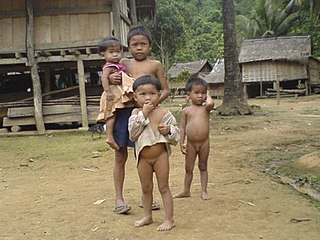Related Research Articles
The Ơ Đu (O'du) are an aboriginal ethnic group in Vietnam and Laos. Their total population is more than 570.

The Bahnaric languages are a group of about thirty Austroasiatic languages spoken by about 700,000 people in Vietnam, Cambodia, and Laos. Paul Sidwell notes that Austroasiatic/Mon–Khmer languages are lexically more similar to Bahnaric and Katuic languages the closer they are geographically, independently of which branch of the family they belong to, but that Bahnaric and Katuic do not have any shared innovations that would suggest that together they form a branch of the Austroasiatic family, rather forming separate branches.
Mlabri is a language spoken by the Mlabri people in the border area between Thailand and Laos.
Phong, also known as Kniang, is an Austroasiatic language of the Mon–Khmer family, spoken in Laos. Its nearest relatives are the fellow Xinh Mul tongues, the Khang language and Puoc language, both spoken in Vietnam. The number of speakers of Phong-Kniang is estimated at 30,700.
The Katuic peoples live mainly in central Vietnam's Truong Son region and the highlands of south eastern Laos and speak the Katuic languages. The peoples include the Katu, Ta Oi, Pacoh, Bru in Vietnam and the Kuy. The Katuic groups in Laos include the Kuy, Bru, Ta'oih, Kantu, Dakkang, Triw, Chatong and Ngeq.

The Bru are an indigenous ethnic group living in Thailand, Laos, and Vietnam. They speak a Katuic language, kaubru unlike the Brao, who speak a Western Bahnaric language. The Bru are not found in northeastern Cambodia. The Lun, Kreung, Kavet, Amba and Brao Tanap groups in northeastern Cambodia are actually sub-groups of the Brao, not the Bru. The Brao sub-groups in Laos are the Lun, Kavet, Jree, Ka-ying, and the Hamong.
The Mal are an ethnic group native to Laos and Thailand. They are one of two sub-groups of the Lua people.
The Ksingmul, also known as Con Pua, Puộc, and Pụa, are an ethnic group in Vietnam and Laos. In Vietnam, they live primarily in the northwest, in the provinces of Sơn La and Lai Châu. The group numbers approximately 29,503 people and its language is in the Khmuic languages group of the Mon–Khmer language family.

Khmuic peoples refers to a group of ethnic groups of Southeast Asia.
The Lamet people are an ethnic group in Thailand and Laos.
Alak is a language spoken by some 4,000 people in southern Laos, especially in the Provinces of Salavan and Sekong. It is closely related to the language spoken by the Bahnars of Vietnam. It includes two dialects, Alak proper and Harak.
Bit is an Austroasiatic language spoken by around 2,000 people in Phongsaly Province, northern Laos and in Mengla County, Yunnan, China.
Oi is an Austroasiatic dialect cluster of Attapeu Province, southern Laos. The dominant variety is Oy proper, with 11,000 speakers who are 80% monolinguals. The Jeng (Cheng) speak the same language but are ethnically distinct. Speakers follow traditional religions.
The Bit or Bid are an ethnic group living in Laos. There are around 1,500 people left, mainly in a single village, as well as a further 500 or so across the border in China. They speak Bit, a Mon–Khmer language, although most also speak Lao.
Ksingmul is a Mon–Khmer language spoken by the Ksingmul people of Vietnam and Laos.
Nyaheun is a Mon–Khmer language of the Bahnaric branch spoken in southern Laos. Chazée (1999:95) estimates the population at 4,200, while the 1995 Laotian census places the Nyaheun population at 5,152. According to Ethnologue, the language is "vigorous," which means it is spoken by people of all ages in its home community.
Oʼdu, or Iduh, is a Mon–Khmer language of Vietnam and Laos. Once spoken by about 300 people in Tương Dương district, Nghệ An province, Vietnam, it is now considered to be almost extinct.
Mal, also known as Thin, is a Mon–Khmer language of Laos and Thailand. It is one of several closely related languages which go by the names Thin or Prai.
Jru' is a Mon–Khmer language of the Bahnaric branch spoken in southern Laos. It is also known as "Loven", "Laven" or "Boloven" from the Laotian exonym Laven or Loven, which is derived from the Khmer name for the Boloven Plateau. The Jru' people engage in coffee and cardamom cultivation, as well as other agricultural activities.
Jedek is an Aslian language from the Austroasiatic family first reported in 2017. Jedek speakers describe themselves as ethnic Menriq or Batek to outsiders, but their language, although very closely related, is distinct from these languages.
References
- Simons, Gary F. and Charles D. Fennig (eds.) 2017, Ethnologue (twentieth edition, online)
- Schliesinger, Joachim, Ethnic Groups of Laos, vol. 2, White Lotus 2003, ISBN 974-480-036-4